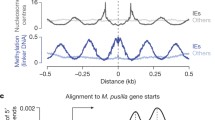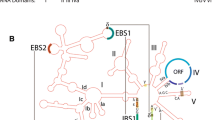Abstract
Recent studies have demonstrated that transposable elements in maize and Drosophila are spliced from pre-mRNA. These transposable element introns represent the first examples of recent addition of introns into nuclear genes. The eight reported examples of transposable element splicing include members of the maize Ac/Ds and Spm/dSpm and the Drosophila P and 412 element families. The details of the splicing of these transposable elements and their relevance to models of intron origin are discussed.
Similar content being viewed by others
References
Berg, D. & M. Howe (eds.), 1989. Mobile DNA. Washington, DC: Am. Soc. Microbiol.
Cavalier-Smith, T., 1985. Selfish DNA and the origin of introns. Nature 315: 283–284.
Cavalier-Smith, T., 1991. Intron phlogeny: a new hypothesis. Trends in Genetics 7: 145–148.
Cech, T., 1990. Self-splicing in group I introns. Ann. Rev. Biochem. 59: 543–568.
Chia, W., G. Howes, M. Martin, Y. Meng, K. Moses & S. Tsubota, 1986. Molecular analysis of the yellow locus of Drosophila. EMBO J. 5: 3597–3605.
Dennis, E., M. Sachs, W. Gerlach, L. Beach & W. Peacock, 1988. The Ds1 transposable element acts as an intron in the mutant allele Adh 1-Fm335 and is spliced from the message. Nucleic Acids Res. 16: 3315–3328.
Doolittle, W., 1987. The origin and function of intervening sequences in DNA: a review. Am. Nat. 130: 915–928.
Fedoroff, N., 1989. Maize transposable elements, pp. 375–411 in Mobile DNA, edited by D. Berg and M. Howe, Washington, DC, Am. Soc. Microbiol.
Fedoroff, N., S. R. Wessler & M. Shure, 1983. Isolation of the transposable maize controlling elements Ac and Ds. Cell 35: 235–242.
Finnegan, D., 1989. Eukaryotic transposable elements and genome evolution. Trends in Genetics 5: 103–107.
Fornwald, J., G. Kuncio, I. Peng & C. Ordahl, 1982. The complete nucleotide sequence of the chick α-actin gene and its evolutionary relationship to the actin gene family. Nucleic Acids Res. 10: 3861–3876.
Fridell, R., A.-M. Pret & L. Searles, 1990. A retrotransposon 412 insertion within an exon of the Drosophila melanogaster vermilion gene is spliced from the precursor RNA. Genes & Dev. 4: 559–566.
Geyer, P., K. Richardson, V. Corces & M. Green, 1988. Genetic instability in Drosophila melanogaster: P-element mutagenesis by gene conversion. Proc. Natl. Acad. Sci. USA 85: 6455–6459.
Geyer, P., A. Chien & V. Corces & M. Green, 1991. Mutations in the su(s) gene affect RNA processing in Drosophila melanogaster. Proc. Natl. Acad. Sci. USA 88: 7116–7120.
Gierl, A., 1990. How maize transposable elements escape negative selection. Trends in Genetics 6: 155–158.
Gierl, A., H. Cuypers, S. Lutticke, A. Pereira, Z. Schwarz-Sommer, et al. 1988. Structure and funtion of the En/Spm transposable element of Zea mays, pp. 155–120. in Plant Transposable Elements, edited by O. Nelson Jr., New York Plenum.
Goodall, G. & W. Filipowicz, 1991. Different effects of intron nucleotíde composition and secondary structure on pre-mRNA splicing in monocot and dicot plants. EMBO J. 10: 2635–2644.
Hehl & Baker, 1989. Induced transposition of Ds by a stable Ac in crosses of transgenic tobacco plants. Mol. Gen. Genet. 217: 53–57.
Hickey, D., 1982. Selfish DNA: a sexually-transmitted nuclear parasite. Genetics 101: 519–531.
Kim, H., J. Schiefelbein, V. Raboy D. Furtek & O. E. Nelson, 1987. RNA splicing permits expression of a maize gene with a defective Suppressor-mutator transposable element insertion in an exon. Proc. Natl. Acad. Sci. USA 84: 5863–5867.
Klein, A. & O. E. Nelson Jr. 1984. Characterization of an Spm-controlled bronze-mutable allele in maize. Genetics 106: 769–779.
Lambowitz, A. 1989. Infectious introns. Cell 56: 323–326.
Menssen, A., W. M. Hohmann, P. Schnable, P. A. Peterson, H. Saedler & A. Gierl. The En/Spm transposable element of Zea mays contains splice sites at the termini generating a novel intron from a dSpm element in the A2 gene. EMBO J. 9: 3051–3057.
Mount, S., M. Green & G. Rubin, 1988. Partial revertants of the transposable element-associated suppressible allele whiteapricot in Drosophila melanogaster: structures and responsiveness to genetic modifiers. Genetics 118: 221–234.
Mullins, M., D. Rio & G. Rubin, 1989. Cis-acting DNA sequence requirements for P-element transposition. Genes & Dev. 3: 729–738.
Pret, A. & L. Searles, 1991. Splicing of retrotransposon insertions from transcripts of the Drosophila melanogaster vermilion gene in a revertant. Genetics 129: 1137–1145.
Raboy, V., H. Kim, J. Schiefelbein & O. E. Nelson Jr., 1989. Deletions in a dSpm insert in a maize bronze-1 allele alter RNA processing and gene expression. Genetics 122: 695–703.
Rogers, J., 1985. Exon shuffling and intron insertion in serine protease genes. Nature 315: 458–459.
Rogers, J., 1990. The role of introns in evolutions. FEBS Letters 268: 339–343.
Searles, L., R. Ruth, A. Pret, R. Fridell & A. Ali, 1990. Structure and transcription of the Drosophila melanogaster vermilion gene and several mutant alleles. Mol. Cell. Biol. 10: 1423–1431.
Shah, D., R. Hightower & R. Meagher, 1983. Genes encoding actin in higher plants: Intron positions are highly conserved but the coding sequences are not. J. Mol. Appl. Gen. 2: 111–126.
Sharp, P., 1985. On the origin of RNA splicing and introns-a review. Cell. 42: 397–400.
Spradling, A. & G. Rubin, 1982. Transposition of cloned P elements into Drosophila germline chromosomes. Science 218: 342–347.
Varagona, M. & S. R. Wessler, 1990. Implications for the cisrequirements for Ds transposition based on the sequence of the wx-B4 Ds element. Mol. Gen. Genet. 220: 414–418.
Voelker, R., W. Gibson, J. Graves, J. Sterling & M. Eisenberg, 1991. The Drosophila suppressor-of-sable gene encodes a polypeptide with regions similar to those of RNA-binding proteins. Mol. Cell. Biol. 11: 894–905.
Walbot, V., 1985. On the life strategies of plants and animals. Trends in Genetics 1: 165–169.
Weil, C. & S. Wessler, 1990. The effects of plant transposable element insertion on transcription initiation and RNA processing. Ann. Rev. Plant Phys. Plant Mol. Biol. 41: 527–552.
Wessler, S., 1988. Phenotypic diversity mediated by the maize transposable elements Ac and Spm. Science 242: 399–405.
Wessler, S., 1989. The splicing of maize transposable elements from pre-mRNA-a minireview. Gene 82: 127–133.
Wessler, S., 1991a. Alternative splicing of a Ds element from exon sequences may account for two forms of Wx protein encoded by the wx-m9 allele. Maydica 36: 317–322.
Wessler, S., 1991b. The maize transposable Ds1 element is alternatively spliced from exon sequences. Mol. Cell. Biol. 11: 6192–6196.
Wessler, S. G. Baran & M. Varagona, 1987. The maize tranpposable element Ds is spliced from RNA. Science 237: 916–918.
Wessler, S., G. Baran, M. Varagona & S. Dellaporta, 1986. Excision of Ds produces waxy proteins with a range on enzymatic activities. EMBO J. 5: 2427–2432.
Author information
Authors and Affiliations
Rights and permissions
About this article
Cite this article
Purugganan, M., Wessler, S. The splicing of transposable elements and its role in intron evolution. Genetica 86, 295–303 (1992). https://doi.org/10.1007/BF00133728
Received:
Accepted:
Issue Date:
DOI: https://doi.org/10.1007/BF00133728




